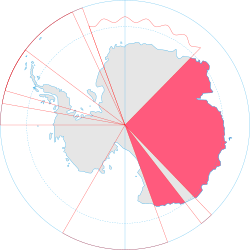Australian Antarctic Territory
|
Australian Antarctic Territory |
|
|---|---|

|
|

Map of Antarctica indicating
Australian territorial claim (red area). |
|
| Status | External Territory |
| Capital | Davis Station |
| Largest research station | Mirny Station (Russian) |
| Sovereign state | Australia |
| Government | Territory of Australia |
|
• Governor-General
|
Sir Peter Cosgrovea |
| Area | |
|
• Total
|
5,896,500 km2 (2,276,700 sq mi) |
| Population | |
|
• Estimate
|
less than 1,000 |
| Currency | Australian dollar |
| Calling code | +672 |
The Australian Antarctic Territory (AAT) is a part of Antarctica. It was claimed by the United Kingdom and placed under the authority of the Commonwealth of Australia in 1933. It is the largest territory of Antarctica claimed by any nation. In 1961, the Antarctic Treaty came into force. Article 4 deals with territorial claims, and although it does not renounce or diminish any preexisting claims to sovereignty, it also does not prejudice the position of Contracting Parties in their recognition or non-recognition of territorial sovereignty. As a result, only four other states recognise Australia's claim to sovereignty in Antarctica.
AAT consists of all the islands and territory south of 60°S and between 45°E and 160°E, except for Adélie Land (136°E to 142°E), which divides the territory into Western AAT (the larger portion) and Eastern AAT. It is bounded by Queen Maud Land in the West and by Ross Dependency in the East. The area is estimated at 5,896,500 km2.
The territory is inhabited by the staff of research stations. The Australian Antarctic Division administers the area primarily by maintaining three year-round stations (Mawson, Davis and Casey), which support various research projects.
The territory is divided into nine districts, which are from West to East:
Australia claims an Exclusive Economic Zone (EEZ) from the Australian Antarctic Territory. However, the Australian proclamation of an Antarctic EEZ is contested. The effect of Article IV of the 1959 Antarctic Treaty (which prohibits new territorial claims or the extension of existing claims in the Antarctic) would seem to be that an EEZ cannot be claimed in relation to territory to which that Treaty applies (south of 60° South). The provisions of the United Nations Convention on the Law of the Sea (UNCLOS) define the exclusive economic zone of a coastal state as up to 200 nautical miles (370 km) from the baseline from which the territorial sea is measured.
...
Wikipedia
